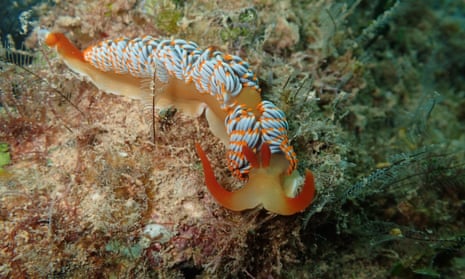The Western Australian museum is running a public competition to name a new species of “flamboyant sea-slug”, part of an order named nudibranch.
The blue and orange creature is up to 8cm long and looks like a cross between a slug and a Pokémon.
It was discovered by WA scientist Dr Nerida Wilson during a diving expedition off the coast of Dampier, about 1,500km north of Perth, in 2000.
Wilson said the nudibranch was “very memorable” and “has an impressive display to scare off predators”, which consists of puffing up its cerata, the orange-tipped blue sausages that line its body, and waggling them at suspected attackers.
The purpose of the cerata is to increase the slug’s surface area and allow it to take in more oxygen. They’re brightly coloured to reflect the toxins in the nudibranch’s diet, which it in turn extrudes through its skin.
Wilson said it had taken 16 years to determine it was a new species of nudibranch, due to the sheer abundance of nudibranchs in Australian waters.
She has handed the task of naming the creature over to the public, running a competition in conjunction with Radio National’s Off Track program to determine the second part of the scientific name, which will begin with the genus Moridilla.
Program host Ann Jones said this nudibranch was “one of the weirdest creatures I’ve ever come across — it has ice blue sausages all over its back, it’s a hermaphrodite, it does an amazing dance when it’s threatened where it waves its sausages around and it goes through a metamorphoses sort of like a butterfly.”
Going to enter the comp to Name the new Nudibranch species? Read this 'how-to' first https://t.co/rK1dWwxeIV pic.twitter.com/P29tW3i8t9
— Ann Jones (@jones_ann) August 8, 2016
There are about 3,000 recognised species globally, and discovery is apparently so common that a website dubbed “Gary and Dave’s world of nudibranchs” based out of the Sunshine Coast in Queensland, includes a how-to guide on naming the gastropods.
Those searching for inspiration can try the Nudibranch Central facebook page, which warns prospective nudibranch enthusiasts not to misinterpret the name. (“There are NO NUDISTS here only sea slugs,” it says.)
The name “nudibranch” means naked gills and is a reference to those cerata, or feathery gills.
It’s also pronounced NEW-dih-bronk, according to the National Geographic, so be sure to adjust your pronunciation of the inevitable Moridilla Nudi McNudibranch accordingly.
Names must be submitted by Monday .

Comments (…)
Sign in or create your Guardian account to join the discussion